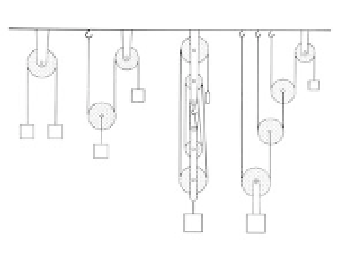Environmental Engineering Reference
In-Depth Information
7.2 (a) Three classes of levers. (b) Simple pulley and com-
pound pulleys. The third compound pulley could lift a 400-kg
load with a force of only 50 kg, but a lift of 5 m would need
pulling 40 m of the counterweight cord. (c) Compound pulley
from Ramelli's (1588) book of machines.
are baseball bats, hockey sticks, and the arms of electric
shovels used in surface mines.
Other common forms of ancient levers ranged from
the water-raising sh¯d¯f (see section 6.4) to ship oars.
The Chinese wheelbarrow, introduced during the Han
dynasty, was a remarkably effective second-class lever.
With its load above the axle of its central wheel, a worker
could move 150-160 kg, sometimes lightening the task
with a small sail. In contrast, European barrows, intro-
duced during the high Middle Ages, were much harder
to push because they had the fulcrum (wheel) at the end
rather than in the center; loads of 60-100 kg were max-
ima on good roads and with very slow speeds.
The wheel and axle form a peculiar lever whose long
arm is the distance between the axle and the wheel's
outer rim and whose short arm is the axial radius. A large
difference between the two arms results in a huge
mechanical advantage even with heavy wheels and high
axial and surface friction. This invention, first used in
Mesopotamian before 3000
B
.
C
.
E
. and independently
developed in China just a few centuries later, relied first
on solid wooden wheels. Spoked wheels, introduced on








































